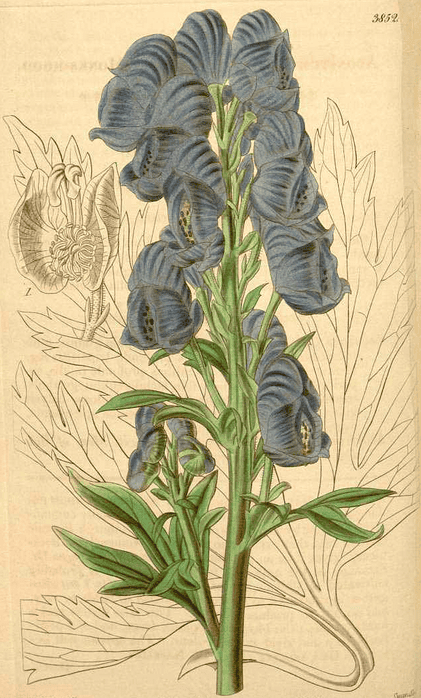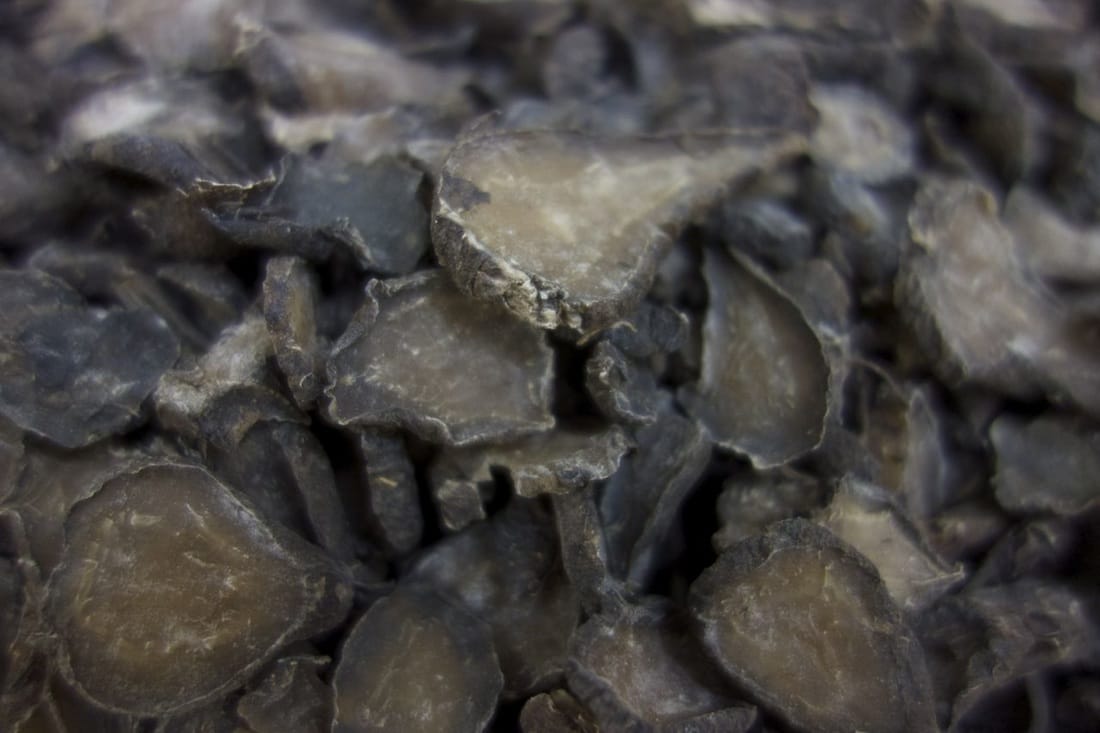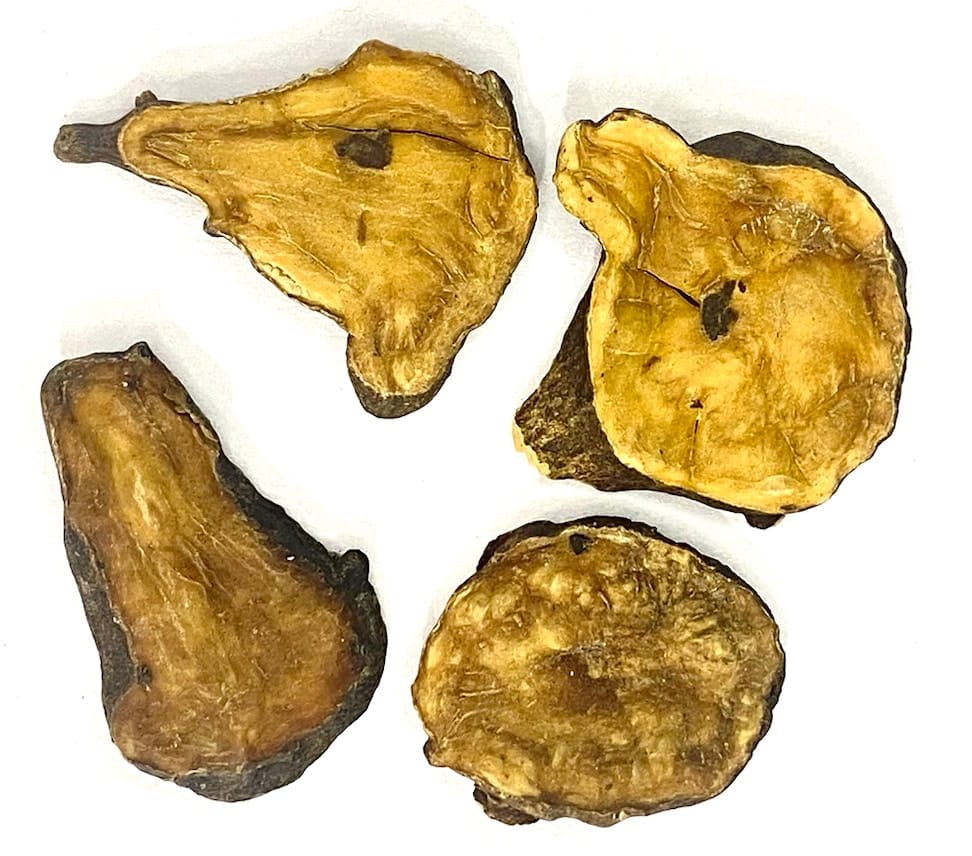Prepared Aconitum, Zhi Fu Zi, 制附子Sichuan Aconite accessory root, Aconite Daughter rootFu Zi, Su Fu Zi (prepared) (TCM) |

|
 Curtis’s Botanical Magazine, 1841
Curtis’s Botanical Magazine, 1841

|

|
(Adam, 2020)
 Aconitum Pao Fu Zi (“Fried Aconitum Fu Zi“)
Aconitum Pao Fu Zi (“Fried Aconitum Fu Zi“)(Adam, 2024)
More Photos of Aconite
The Aconite Species of the West
Experiments on Aconite of Dr. Storck
Botanical name:
Aconitum carmichaeli (syn. A. chinense) (TCM)
A number of Aconite species are used in the various systems:
1. Europe: A. napellus
2. India & Tibet:
a. A. chasmanthum
b. A. ferox (Nepalese Aconite)
The above species are synonymous in effect, just the strength may vary. This is especially so with Wild versus farmed varieties. In TCM, the majority of the root of Fu Zi is farmed, whereas other varieties of Aconite (Chuan Wu, Cao Wu) are gathered from the wild and are much more toxic. It appears most of that on the Indian market is wild-crafted, leading to its possible greater strength.
Parts used:
Prepared ‘Daughter’ (accessory) root
The main root is also used, see Aconitum Wu Tuo
Temperature & Taste:
Hot, dry. Pungent, Extremely Toxic
Classification:
M. Warm to Expel Cold
Uses:
1. Warms the Yang, Clears Cold:
-marked coldness and Yang deficiency of the Heart, Spleen or Kidney
-cold chest pain with palpitations and shortness of breath
-cold abdominal pain with watery diarrhea and undigested food, nausea
-cold pain of the lower back, lower back pain, copious clear urine, impotence
-‘Febrile diseases caused by Cold’ … ‘Malaria due to excess Cold’ (Li Shi Zhen)
-has Yang tonifying qualities (which is not seen in the Aconite main root)
2. Revives the Yang:
-devastated Yang and where Cold is in excess; frigid extremities, pale complexion, faint pulse
-diarrhea with undigested food, feeling very cold, cold extremities and very faint pulse
-severe sweating, vomiting or diarrhea,
-important herb for Yang collapse as a result of Shock
3. Clears Cold-Wind-Damp, Eases Pain:
-Wind-Cold-Damp painful obstruction of the muscles, joints and channels
-internal cold obstructing the organs
-‘Severe intermittent Headache’ (Li Shi Zhen)
-the Wild versions (Chuan Wu, Cao Wu, Wu Tou etc) are stronger for this effect
4. Externally:
-Cold-Damp type Muscle and Joint pain
-chronic ulcers and fistulas
-Sores from Cold (dark-colored)
-sudden deafess (from Wind-Cold)
-Throat Inflammation (hold Fu Zi and Honey in the mouth and swallow the juice)
Symptom Picture:
According to TCM, the symptoms picture for a patient appropriate to the use of Aconite is: a feeling of coldness, cold limbs, a pale, flabby tongue with a white or greasy coating, a weak pulse or a deep and slow pulse and clear urine. Various other symptoms may be present such as lower back pain and weakness, cold pain in the joints, impotence.
Dose:
1. The root is always bought ready-prepared in factories. Therefore, it is common practice for a practitioner to taste a new batch of Aconite. If it is numbing to taste, it is still potentially toxic.
2. When decocted (typical use in TCM) it must be cooked for up to an hour (30–60 minutes before adding the other herbs). Larger doses are boiled for longer periods. In addition, cooking with Ginger and/or Licorice can enhance its function of warming Yang while reducing toxicity.
3. The root should be soaked and washed in water before decocting to remove salts used in its preparation.
4. If the root is used in powdered form, the broken pieces of root should be dry-fried in a hot wok until they become slightly yellowed to further reduce toxicity.
5. In any dosage form, the addition of Licorice and/or Ginger root is wise.
6. Individual response can be varied. Some people may experience mild side effects within the dosage range while others can take far larger doses.
7. Tolerance develops meaning doses can generally be increased if required.
8. It is always wise to begin with lower doses, increasing as needed.
Decoction: 3–15 grams, boiled for 30–60 minutes before adding other herbs (total cooking time minimum 1–1½ hours).
To rescue the Yang (such as in Shock or collapse from Yang deficiency): 15–30 grams in decoction.
Prepared root in powder and pills: 10–50mg (up to 100 or 200mg)
In the ‘Sichuan Fire School’ (Huo Shen Pai) large doses of aconite are used, sometimes up to 200 grams per day.
In these cases:
1. Begin with lesser doses increasing as required.
2. Large doses require longer boiling. For example, a 50 gram dose may be boiled for 2 or more hours; 100 grams for 4 hours.
3. It is always advisable to use adequate amounts of correctives (detoxicants) such as Ginger and Licorice.
4. Individuals response to the drug dictates how far the dose is raised.
5. Formulas specific to the ‘Huo Shen Pai‘ School are generally used when large doses are given.
Preparation:
Various methods of preparation are employed. Processing is never carried out by practitioners, but the root is prepared in factories to be supplied to the medicine market. There are a number of different preparations used in China, but generally only White and Black types as pictured above are available on the Western market.
1. Prepred Aconitum Fu Zi (Zhi Fu Zi):
Usually, preparation involves soaking a number of times in water or brine, and cooking with herbs or salts, then drying. The modern method of processing is more elaborate but based on this same process.
A variation: Soak the root in water until it cracks, peel off the bark and stew the root. Remove and cut into slices while hot. Stir-fry the slices until yellowed and dried. (Li Shi Zhen)
2. Lime-prepared Aconitum Fu Zi:
Soak the fresh sliced root in water for a day. Remove and cover the pieces with Lime, changing the Lime several times until the drug is fully dry. (Han Bao Sheng)
3. Aconitum Dan Fu Pian:
Prepared with Licorice and Soy bean. It is less toxic than Hei Fu Pian and Bai Fu Pian.
A traditional variation of this is to soak the sliced root in water with Black Soybeans for 5 days, then remove and dry in the sun. (Lei Xiao)
4. Dry-fried Aconitum Fu Zi (Pao Fu Pain):
The fresh root is Dry-fried in sand. This is the least toxic preparation.
Traditionally, the roots were buried in hot ashes until they crack but before they are over-scorched. Then they are taken out and broken to pieces. Some stated the ashes of willow tree should be used.
5. Vinegar-prepared Aconitum Fu Zi:
Soak the fresh root in Vinegar in a sealed vessel for 1 month. Then remove and dry in the sun. (Li Shi Zhen; this method.of processing is no longer used)
Vinegar prepared from Barley porridge was also used. The drug was steeped for several days in the sour Barley water, stirring daily, then dried in the sun for 100 days. (Su Song)
6. Urine-prepared Aconitum (India):
In India, the root is prepared by soaking in Cow urine for 3 days, changing the urine daily.
In TCM classics, the root was steeped in boys urine until completely soaked, then stewed in the same. It is then removed and dried. It is better with a little Salt added.
Another version suggested soaking the roots in Boy’s urine for 14 days, then slicing into 4 pieces. Then wash and soak in water for 7 days, changing the water daily.
This reduces toxicity and promotes the downward function of Aconite. (Zhu Zhen Heng)
7. Licorice and Ginger Prepared Aconitum Fu Zi:
Put one root in half a cup each of Salt Water, Ginger juice and Boy’s urine, along with 6 grams of Licorice. Stew the root until well cooked. Remove and leave for a night. The toxicity is then much reduced. (Li Shi Zhen)
8. Unprocessed Aconitum Fu Zi:
The unprocessed product is not generally used internally. It is very toxic, but is sometimes used in external medicine (but should never be applied to broken skin).
The Tao Hong Jing states that when decoction of fresh Ginger and Aconitum Fu Zi was prepared, the fresh root was used. While Ginger corrects the poison of Aconite, the fresh root is not used internally today.
Li Shi Zhen said if raw Aconitum Fu Zi is used, it should be processed as follows: the roots are soaked in water until the roots crack, then the bark should be peeled off. Then it is boiled, sliced, dried, then stir-fried until yellowed inside and out. Leaving the prepared drug for a while before using further reduces the Fire Toxin. (Li Shi Zhen)
However, in parts of Sichuan, the dried, unprepared root is occasionally used in cooking where it is stewed with meat (mutton or goat) for 6–9 hours as a traditional dish (personal communication).
Correctives:
1. Ginger (TCM)
2. Licorice (TCM)
3. Ginseng (Tao Hong Jing). Ginseng has been found more effective than Licorice to correct toxicity. (see here).
4. Saposhnikovia Fang Feng is said to reduce toxicity of Aconite. (Ten Lectures on the Use of Medicinals, Jiao Shu-De)
5. See also the Antidotes below.
Substitutes:
1. Delphinium denudatum (Unani)
2. Various toxic blue-flowered Aconite species can be substituted for Aconitum Fu Zi, the main difference being the degree of toxicity. Wild roots and ‘mother’ roots are most potent, the farmer ‘daughter’ roots after correct processig are least toxic. Aconitum Fu Zi is regarded as being more tonic, the wild and mother roots are more toxic and stronger to clear Wind, Cold and Damp.
Comment:
1. This is a very potent medicine and is responsible for more deaths in China than any other single herbal medicine. Nevertheless, it is a potent and indispensable medicine in TCM, Tibetan Medicine and Ayurveda.
2. There are a number of types of processing methods used.
3. There are two main varieties used: Black Aconite Pieces (Hei Fu Pian) and White Aconite Pieces (Bai Fu Pian), the former retaining its black root skin, the latter having the black skin removed.
4. There are several different Aconites used in TCM, Ayurveda and Tibetan Medicine. In TCM, Zhi Fu Zi, dealt with here, is most used. It is the strongest tonic. Zhi Chuan Wu is less tonic, but is hotter, and better for strong Wind-Cold-Damp pain.
5. The main difference in the use of Aconite is the application of it as an anti-inflammatory, anti-pyretic, febrifuge in Traditions other than TCM. Its other uses, for example Rheumatic and Arthritic disease and Nervous disorders is quite similar.
6. An old TCM addage states ‘Aconitum Fu Zi is not hot without Ginger’. Ginger increases the Yang tonifying effect of Aconite while simultaneously reducing Toxicity. The same can be said of Cinnamon, which likewise enhances the warming, Yang tonifying effect of Aconite while reducing toxicity.
7. The unprcessed Drug (which was sometimes used classically) is very dispersing, the processed root is tonifying. (Li Shi Zhen)
Main Combinations:
With Ginger makes its effect very Heating and warms the Yang.
With fresh Ginger makes it more dispersing.
With Licorice to moderate and slow its effect.
With Cinnamon to lead Fire back to the Ming Men (in the lower abdomen)
With Ginseng to tonify Kidney Yang.
With Phellodendron Huang Bai to Lead the Yang to its source while clearing Deficient-Heat or Damp-Heat.
1. Devastated Yang with marked coldness, cold extremities, fatigue, lethargy, chills, watery diarrhea, faint pulse, Aconitum Fu Zi with dry Ginger Gan Jiang and Licorice, as in Si Ni Tang. If Qi is very weak, Ginseng is added to form Si Ni Jia Ren Shen Tang.
2. Kidney Yang deficiency, with coldness, weak and painful lower back, impotence, urinary frequency, Aconitum Fu Zi with Rehmannia Shu Di, Cinnamon and Dioscorea Shan Yao. If there is lower back pain and weakness, add Eucommia Du Zhong.
3. Spleen and Kidney Yang deficiency with fluid accumulation, edema, abdominal pain, heaviness of the extremities, Aconitum Fu Zi with Atractylodes Bai Zhu, Paeonia Bai Shao, Poria Fu Ling and fresh Ginger. This is Zhen Wu Tang, True Warrior Decoction.
4. Spleen Yang deficiency with loose bowel, nausea, poor appetite, cold abdominal pain, Aconitum Fu Zi with Atractylodes Bai Zhu, dry Ginger (Gan Jiang) and Licorice (as in Fu Zi Li Zhong Wan)
5. Heart Yang deficiency, with coldness, palpitations, shortness of Breath, Aconitum Fu Zi with Ginseng, Licorice and Cinnamon (Rou Gui) or Cinnamon twig (Gui Zhi)
6. External Wind-Cold in someone with Yang deficiency, Aconitum Fu Zi combine with Ephedra Ma Huang and Asarum Xi Xin and fresh Ginger. This is only suitable for strong individuals.
7. Benign Prostatic Hyperplasia: Aconitum Fu Zi, Morinda Ba Ji Tian, Cornus Shan Zhu Yu, Cistanche Rou Cong Rong, Dodder seed (Tu Si Zi), Psoralea Bu Gu Zhi, Fenugreek (Hu Lu Ba), Dendrobium Shi Hu, Fennel seed (Xiao Hui Xiang). This is a Korean Formula called Ga Gam Nai Go Hyan and has been studied here)
8. Prostate Cancer, Aconitum Fu Zi, Ginger, Angelica gigas (1:1:2) (This has been studied and found effective)
9. Boils and Wounds, Aconitum Fu Zi, Ginger juice, Dragons Blood (Xue Jie), Sesame seed (Hei Zi Ma), Flowers of Sulphur, Pangolian scales, formed into Pills (Chinese Materia Medica, Stuauoft)
10. Sudden Deafness, blend with Spring Onion jucie and drop in the ear. (Li Shi Zhen)
Major Formulas:
Da Huang Fu Zi Tang
Fu Zi Tang
Fu Zi Li Zhong Wan
Ma Huang Fu Zi Xi Xin Tang
Shen Fu Tang
Shen Qi Wan
Zhen Wu Tang
Zan Yu Dan
Shi Pi Yin
Si Ni Tang
You Gui Yin
Cautions:
1. Extremely toxic in its unprepared state. Even the prepared drug is toxic in overdose. A number of deaths occur each year in China from Aconite poisoning.
2. Each batch of the preared root should be tested by tasting a little piece. If there is a numbing effect, the root requires further processing.
3. Only the prepared root is used internally.
4. It is wise to begin with lesser doses, increasing as needed. Cooking time can also be longer to begin with (2 hours), reducing cooking time over a number of days.
Toxicity:
LD50 of unprepared Aconitum Fu Zi orally in mice is 5.5 mg/kg.
LD50 of prepared Aconitum Fu Zi orally in mice is 161 mg/kg.
1. In vivo acute toxicity of detoxified Fuzi (lateral root of Aconitum carmichaeli) after a traditional detoxification process
2. Evaluation of Long-Time Decoction-Detoxicated Hei-Shun-Pian (Processed Aconitum carmichaeli Debeaux Lateral Root With Peel) for Its Acute Toxicity and Therapeutic Effect on Mono-Iodoacetate Induced Osteoarthritis
3. Study of Single-dose Toxicity of Aconitum Kusnezoffii Reichb. Pharmacopuncture in Rats
Antidotes:
NOTE: Overdose from Aconite is potentially lethal and therefore any overdose should be sent to hospital immediately.
1. Licorice (TCM)
2. Ginger, fresh and dried (TCM)
3. Cinnamon–infuse 5–10 grams of Cinnamon in hot water and drink, repeating if necessary.
4. Garlic
5. Asafetida
6. Anthora (Aconitum anthora) was regarded as a specific antidote to the toxic Aconites. Anthora is a non-toxic (less toxic) species of Aconite. Similarly, in Tibetan Medicine, non-toxic (less toxic) species of Aconite (A. heterophyllum etc.) are regarded as counterpoisons to the toxic Aconites.
7. Delphiniums are closely allied to the Aconites. D. denudatum has, similar to the above-mentioned Aconites, been regarded as an antidote to the toxic Aconites.
8. Ground Pine: “It is an especial thing for the Poison of the Aconites of all sorts”. (Culpeper)
9. Herb True-Love: ‘The leaves or berries thereof are effectual to expel Poison of all sorts, especially that of the Aconites’. (Culpeper)
10. Purified Borax is regarded as an antidote in Ayurveda. Recent research has shown it to be an effective antidote to both acute and sub-acute Aconite poisoning.
11. Musk is an “Antidote for poisons specially for Aconite” (Avicenna)
12. Compound Decoctions from TCM:
i. Fresh Ginger, Licorice, Mung Bean (Lu Dou), Black Soy bean (Hei Dou), Sophora Ku Shen; Coptis Huang Lian, Ginseng; Astragalus Huang Qi (dosage of each herb depends on symptoms)
ii. irregular Heartbeat: Sophora Ku Shen (20 grams), Licorice (10 grams).
iii. Cold extremities and very weak pulse, Ginseng, Licorice, dry Ginger
Main Preparations used:
Prepared Aconite Root (Zhi Fu Zi)
GENERAL / REVIEW:
–Simultaneous quantification of nine aconitum alkaloids in Aconiti Lateralis Radix Praeparata and related products using UHPLC–QQQ–MS/MS
DETOXIFICATION / PROCESSING:
–The toxicology and detoxification of Aconitum: traditional and modern views
–In vivo acute toxicity of detoxified Fuzi (lateral root of Aconitum carmichaeli) after a traditional detoxification process
–Changes in the properties of Radix Aconiti Lateralis Preparata (Fuzi, processed aconite roots) starch during processing
CARDIAC:
–Traditional Chinese Medicine for Bradyarrhythmia: Evidence and Potential Mechanisms
SEPTIC SHOCK:
–Simultaneous use of traditional Chinese medicine (Si-Ni-Tang) to treat septic shock patients: study protocol for a randomized controlled trial
ARTHRITIS / JOINT DISEASE:
–Application of GC/MS-Based Metabonomic Profiling in Studying the Therapeutic Effects of Aconitum carmichaeli with Ampelopsis japonica Extract on Collagen-Induced Arthritis in Rats
–Evaluation of Long-Time Decoction-Detoxicated Hei-Shun-Pian (Processed Aconitum carmichaeli Debeaux Lateral Root With Peel) for Its Acute Toxicity and Therapeutic Effect on Mono-Iodoacetate Induced Osteoarthritis
–How Aconiti Radix Cocta can Treat Gouty Arthritis Based on Systematic Pharmacology and UPLC-QTOF-MS/MS
–Insights into the Action Mechanisms of Traditional Chinese Medicine in Osteoarthritis
RHEUMATOID ARTHRITIS:
–Revealing the efficacy-toxicity relationship of Fuzi in treating rheumatoid arthritis by systems pharmacology
–The Effect of Chinese Medicine Compound in the Treatment of Rheumatoid Arthritis on the Level of Rheumatoid Factor and Anti-Cyclic Citrullinated Peptide Antibodies: A Systematic Review and Meta-Analysis
–Uncovering the Complexity Mechanism of Different Formulas Treatment for Rheumatoid Arthritis Based on a Novel Network Pharmacology Model
–Wu-Tou Decoction in Rheumatoid Arthritis: Integrating Network Pharmacology and In Vivo Pharmacological Evaluation
DIABETIC NEUROPATHY:
–Yang-warming method in the treatment of diabetic peripheral neuropathy: an updated systematic review and meta-analysis
CYTOTOXIC:
–Diterpenoid Alkaloids from the Chinese Traditional Herbal “Fuzi” and Their Cytotoxic Activity
–Cytotoxicity of Aconitum alkaloid and its interaction with calf thymus DNA by multi-spectroscopic techniques
CANCER:
–Targeting Anti-Cancer Active Compounds: Affinity-Based Chromatographic Assays
